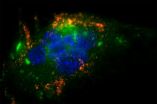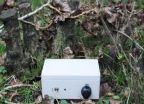(Press-News.org) This news release is available in German.
Scientists have discovered that a polymer can provide a key to get into tumors: Prof. Prasad Shastri, Director of the Institute of Macromolecular Chemistry and core member of the cluster of excellence BIOSS Centre for Biological Signalling Studies at the University of Freiburg, and graduate students Julia Voigt and Jon Christensen have developed a new paradigm to home nanoparticles, containers that measure a few 100 nanometers in size, to endothelial cells. Using just charged polymers with the right affinity for cell lipids the team has developed nanoparticles that can recognize specific cell types simply by their chemical properties. "This is a remarkable discovery, as it allows for the first time to target a specific cell type purely through biophysical principles, and without using the traditional ligand-receptor approach" says Prof. Shastri who led the study that was selected as cover article of the Proceedings of the National Academy of Sciences. Until now researchers placed molecules on nanoparticles that can latch onto proteins on cell surface - called receptors.
These receptors act as an address or a biological postal code. However in tumors these addresses can change rapidly with time. To solve this lack of precision Shastri and team developed particles that are delivered to endothelial cells using a biophysical approach. "This delivery approach does not require a biological postal code for targeting of nanoparticles and is an important step forward in developing nanoparticle based systems for treating cancers" says Julia Voigt the lead author of the paper.
Cancers are very hungry tissues and they need constant nourishment. This is provided through their own supply of blood vessels. "By going after endothelial cells that make up these blood vessels, we can starve the tumor or kill it with one payload" says Jon Christensen who is a co-author on this study and works on tumor metastasis.
Nanoparticles are used to deliver therapeutics in treating cancers. These very small pills, cornerstones of nanomedicine, get injected into the body and reach the tumor cells via the bloodstream. When they find the targeted cells, they need to be eaten so that the drug can act within the cell. This mechanism is called receptor-mediated endocytosis. Shastri and his team looked to develop a new approach that targets a transport process that is dominant in endothelial cells. It turns out that a structure called caveolae is found in large amounts on endothelial cells. Caveolae are "lipid rafts" on the cell membrane and are one of the doors into the endothelial cells. Prof. Shastri and his team discovered that by decorating nano-pills made of lipids with negatively charged polymers, nanoparticles can preferentially enter through this door. "How exactly these charged polymers enable the nanoparticles to unlock this door we are not sure yet, but we feel confident that with further studies this method could usher in a new approach to delivery of drugs in general" says Shastri. This project was funded by Nano@matrix supported by INTERREG and the cluster of excellence BIOSS Centre for Biological Signalling Studies.
INFORMATION:
Original Publication:
Julia Voigt, Jon Christensen, V. Prasad Shastri
Differential uptake of nanoparticles by endothelial cells through
polyelectrolytes with affinity for caveolae
PNAS Online Early Edition 2014
Contact:
Prof. Dr. V. Prasad Shastri
Institute for Macromolecular Chemistry and BIOSS Centre for Biological Signalling Studies
University of Freiburg
Phone: 0761/203- 6268
E-Mail: prasad.shastri@makro.uni-freiburg.de
A new postal code for cancer
Freiburg researchers find purely chemical way to target therapeutic nano-containers to cells
2014-02-11
ELSE PRESS RELEASES FROM THIS DATE:
Urban bees using plastic to build hives
2014-02-11
Once the snow melts, Canada's bee population will be back in business -- pollinating, making honey and keeping busy doing bee things. For at least two urban bee species, that means making nests out of plastic waste.
A new study by a University of Guelph graduate and a U of G scientist reveals that some bees use bits of plastic bags and plastic building materials to construct their nests. The research was published recently in the journal Ecosphere.
It's an important discovery because it shows bees' resourcefulness and flexibility in adapting to a human-dominated world, ...
MIT robot may accelerate trials for stroke medications
2014-02-11
The development of drugs to treat acute stroke or aid in stroke recovery is a multibillion-dollar endeavor that only rarely pays off in the form of government-approved pharmaceuticals. Drug companies spend years testing safety and dosage in the clinic, only to find in Phase III clinical efficacy trials that target compounds have little to no benefit. The lengthy process is inefficient, costly, and discouraging, says Hermano Igo Krebs, a principal research scientist in MIT's Department of Mechanical Engineering.
"Most drug studies failed and some companies are getting ...
First observation of a human HAT, key proteins in numerous pathologies
2014-02-11
The researcher Manuel Palacín, head of the Heterogenic and Multigenic Diseases lab at the Institute for Research in Biomedicine (IRB), in Barcelona, is among the world's experts in HATs (heteromeric amino acid transporters).
In humans, there are eight HAT molecules. These are associated, for example, with the following: rare diseases called aminoacidurias, such as lysinuric protein intolerance and cystinuria; the development of infections caused by the Kaposi sarcoma virus; various types of cancer; and relapse in cocaine use. HATs are, as the name implies, amino acid ...
Rare cancers: the challenge of accurate diagnosis -- press release
2014-02-11
Brussels, Belgium, 11 February 2014 -- Inaccurate diagnosis is a major obstacle for the proper treatment of patients with rare cancers. A Consensus on Improving the Pathologic Diagnosis of Rare Cancers was presented today by RARE CANCERS EUROPE, together with the European Society for Medical Oncology (ESMO) and the European Society of Pathology (ESP) in Brussels. The recommendations aim to help rare cancer patients get a timely and accurate diagnosis.
The statement is the result of a two-day workshop, where the particular challenges for each type of rare cancer(1) were ...
Could statins be used to fight a deadly viral infection?
2014-02-11
Two Perelman School of Medicine microbiologists may have found a way to use statins, the well-known blockbuster cholesterol-lowering drugs, to fight the hantavirus, a mysterious and lethal microorganism that appeared suddenly in the US southwest over 20 years ago. That first outbreak led to the deaths of more than a dozen people, most of them in their prime. The last reported outbreak happened in Yellowstone Park in 2012.
Only about 30 known human cases of hantavirus are reported in the US each year. The respiratory syndrome caused by a hantavirus infection comes from ...
Hacking the environment: bringing biodiversity hardware into the open
2014-02-11
New technologies are changing the way we collect biodiversity data. Data that once required taking expensive, bulky and fragile equipment on field trips can now be collected on cheap, compact and robust devices. In a recent paper in the Biodiversity Data Journal the construction of an environmental data-logger using the Arduino platform is described. It is hoped that this work will encourage the adoption of new data collection technologies by biodiversity scientists and foster new collaborations with both electronics hobbyists and electronics engineers who have an interest ...
Exon skipping prevents formation of toxic protein fragments in Huntington's disease
2014-02-11
New Rochelle, NY, February 11, 2014—An innovative therapeutic strategy for reducing the levels of toxic protein fragments associated with Huntington's disease uses a new approach called exon skipping to remove the disease-causing component of the essential protein, huntingtin. Proof of concept using antisense oligonucleotides to "skip over" the specific exon in a mouse model of Huntington's disease is reported in an article in Nucleic Acid Therapeutics, a peer-reviewed journal from Mary Ann Liebert, Inc., publishers. The article, part of a special focus issue on exon skipping, ...
Excess weight linked to brain changes that may relate to memory, emotions, and appetite
2014-02-11
Being overweight appears related to reduced levels of a molecule that reflects brain cell health in the hippocampus, a part of the brain involved in memory, learning, and emotions, and likely also involved in appetite control, according to a study performed by researchers at SUNY Downstate Medical Center and other institutions. The results of the study were published in Neuroimage: Clinical.
Jeremy D. Coplan, MD, professor of psychiatry at SUNY Downstate, led a multicenter team that visualized the molecule, N-acetyl-aspartate (NAA), using magnetic resonance spectroscopy, ...
RI Hospital: Cognitive behavioral therapy benefits patients with body dysmorphic disorder
2014-02-11
PROVIDENCE, R.I. – In a recent study, researchers at Rhode Island Hospital found significant benefits of cognitive behavioral therapy as a treatment modality for patients with Body Dysmorphic Disorder (BDD). BDD is a common, often severe, and under-recognized body image disorder that affects an estimated 1.7 percent to 2.4 percent of the population. This study demonstrated significant improvement in patients' BDD symptoms and level of disability, as well as high levels of patient satisfaction with the treatment. The study is published online in advance of print in the journal ...
Source of 'moon curse' revealed by eclipse
2014-02-11
Strange events have long been linked to nights of a full moon, though careful scrutiny dispels any association. So, when signals bounced off the lunar surface returned surprisingly faint echoes on full moon nights, scientists sought an explanation in reason rather than superstition. Still, the most compelling evidence arrived during another event that once evoked irrational fears—on a night when Earth's shadow eclipsed the full moon.
Tom Murphy, a physicist at UC San Diego, is among the scientists who have aimed laser beams at suitcase-sized reflectors placed on the moon ...
LAST 30 PRESS RELEASES:
Injectable breast ‘implant’ offers alternative to traditional surgeries
Neuroscientists devise formulas to measure multilingualism
New prostate cancer trial seeks to reduce toxicity without sacrificing efficacy
Geometry shapes life
A CRISPR screen reveals many previously unrecognized genes required for brain development and a new neurodevelopmental disorder
Hot flush treatment has anti-breast cancer activity, study finds
Securing AI systems against growing cybersecurity threats
Longest observation of an active solar region
Why nail-biting, procrastination and other self-sabotaging behaviors are rooted in survival instincts
Regional variations in mechanical properties of porcine leptomeninges
Artificial empathy in therapy and healthcare: advancements in interpersonal interaction technologies
Why some brains switch gears more efficiently than others
UVA’s Jundong Li wins ICDM’S 2025 Tao Li Award for data mining, machine learning
UVA’s low-power, high-performance computer power player Mircea Stan earns National Academy of Inventors fellowship
Not playing by the rules: USU researcher explores filamentous algae dynamics in rivers
Do our body clocks influence our risk of dementia?
Anthropologists offer new evidence of bipedalism in long-debated fossil discovery
Safer receipt paper from wood
Dosage-sensitive genes suggest no whole-genome duplications in ancestral angiosperm
First ancient human herpesvirus genomes document their deep history with humans
Why Some Bacteria Survive Antibiotics and How to Stop Them - New study reveals that bacteria can survive antibiotic treatment through two fundamentally different “shutdown modes”
UCLA study links scar healing to dangerous placenta condition
CHANGE-seq-BE finds off-target changes in the genome from base editors
The Journal of Nuclear Medicine Ahead-of-Print Tip Sheet: January 2, 2026
Delayed or absent first dose of measles, mumps, and rubella vaccination
Trends in US preterm birth rates by household income and race and ethnicity
Study identifies potential biomarker linked to progression and brain inflammation in multiple sclerosis
Many mothers in Norway do not show up for postnatal check-ups
Researchers want to find out why quick clay is so unstable
Superradiant spins show teamwork at the quantum scale
[Press-News.org] A new postal code for cancerFreiburg researchers find purely chemical way to target therapeutic nano-containers to cells




